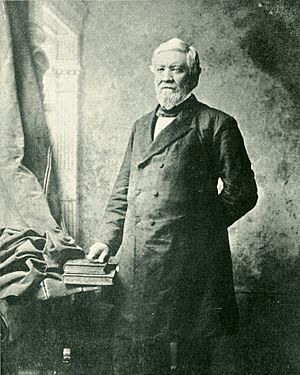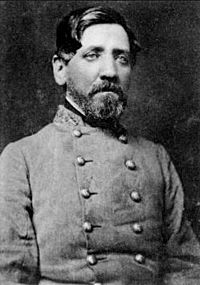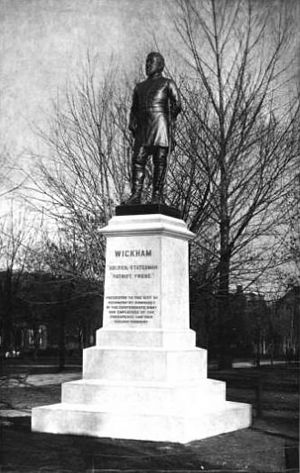Williams Carter Wickham facts for kids
Quick facts for kids
Williams Carter Wickham
|
|
|---|---|
 |
|
| Member of the Virginia Senate from the 32nd district |
|
| In office December 5, 1883 – July 23, 1888 |
|
| Preceded by | Joseph A. Wingfield |
| Succeeded by | Henry T. Wickham |
| Member of the Confederate States House of Representatives from Virginia's 3rd district | |
| In office October 5, 1864 – May 10, 1865 |
|
| Preceded by | James Lyons |
| Succeeded by | None (position eliminated) |
| Member of the Virginia Senate for Hanover and Henrico |
|
| In office December 5, 1859 – December 2, 1861 |
|
| Preceded by | Chastain White |
| Succeeded by | John R. Garnett |
| Member of the Virginia House of Delegates from Hanover County | |
| In office December 3, 1849 – December 2, 1850 |
|
| Preceded by | Richard F. Darracott |
| Succeeded by | Chastain White |
| Personal details | |
| Born | September 21, 1820 Richmond, Virginia, U.S. |
| Died | July 23, 1888 (aged 67) Richmond, Virginia, U.S. |
| Political party | Republican |
| Spouse | Lucy Penn Taylor |
| Children | Henry T. Wickham |
| Alma mater | University of Virginia |
| Military service | |
| Allegiance | |
| Branch/service | |
| Years of service | 1861–1864 |
| Rank | |
| Unit | |
| Battles/wars | American Civil War First Battle of Manassas Battle of Williamsburg Battle of Sharpsburg Battle of Chancellorsville Battle of Brandy Station Gettysburg Campaign Battle of Yellow Tavern |
Williams Carter Wickham (born September 21, 1820 – died July 23, 1888) was an important figure in Virginia history. He was a lawyer and politician. He served in both parts of the Virginia General Assembly, which is like Virginia's state government.
Wickham also became a delegate to the Virginia Secession Convention of 1861. This was a meeting where Virginia decided whether to leave the United States. He voted against leaving. But after Virginia decided to secede, he joined the Confederate States Army. He became a cavalry general. Near the end of the American Civil War, he was even a Confederate Congressman.
After the war, Wickham joined the Republican Party. He helped rebuild Virginia's transportation system. He took over the damaged Virginia Central Railroad. He fixed it and helped it join with the Chesapeake and Ohio Railway company. Working with a businessman named Collis Huntington, Wickham helped develop coal mining. He also helped create the Newport News Shipyard. He was elected to the Virginia Senate again later in life. His son, Henry T. Wickham, also became a lawyer. He worked with his father and later became a leader in the Virginia Senate.
Contents
Early Life and Family
Williams Carter Wickham was born in Richmond, Virginia. His parents were William Fanning Wickham and Anne Butler Wickham. His grandfather, John Wickham, was a well-known lawyer in Richmond.
Wickham's family had deep roots in Virginia. One of his great-grandfathers, General Thomas Nelson, Jr., was very famous. He signed the Declaration of Independence. He also served as governor of Virginia during the American Revolutionary War. Wickham was also related to Robert "King" Carter. He was a powerful and wealthy landowner in early Virginia.
Wickham spent much of his childhood at Hickory Hill. This was a large 3,200-acre (13 km2) plantation. It was located about 20 miles (32 km) north of Richmond. He received a private education. Then he went to the University of Virginia and graduated.
He married Lucy Penn Taylor. They had several children. His son, Henry T. Wickham, followed in his father's footsteps. He also became a lawyer and politician.
Public Service and Military Career
Wickham became a lawyer in Virginia in 1842. He had his own law practice. He also managed plantations that he gained through his marriage. His father continued to run Hickory Hill. It was one of the largest plantations in Hanover County.
Wickham became a local judge in Hanover County. Voters in Hanover County elected him to the Virginia House of Delegates in 1849. He served one term there. A decade later, voters from Hanover and Henrico County elected him to the Virginia Senate.
In 1858, Wickham formed a cavalry company. It was called the "Hanover Dragoons." He became a captain in the Virginia volunteer militia.
In 1861, voters elected Wickham to the Virginia Secession Convention of 1861. He was a Unionist. This means he wanted Virginia to stay in the United States. He voted against Virginia leaving the Union twice.
Civil War Service
After Virginia voted to secede, Wickham joined the Confederate States Army. He brought his company, the Hanover Dragoons, with him. He fought in the First Battle of Manassas. In September 1861, he became a lieutenant colonel in the Fourth Virginia Cavalry.
In May 1862, he was hurt during a cavalry charge. This happened at the Battle of Williamsburg. He was captured while recovering at Hickory Hill. But he was quickly released.
In August 1862, Wickham was promoted to Colonel of the Fourth Virginia Cavalry. He was wounded again at the Battle of Sharpsburg. This time, a shell fragment hit him in the neck. After he recovered, he fought in several major battles. These included Chancellorsville, Brandy Station, and the Gettysburg Campaign.
After the Battle of Gettysburg, Wickham was promoted again. He became a brigadier general on September 9, 1863. He was given command of a group of soldiers known as Wickham's brigade. On May 11, 1864, he fought at the Battle of Yellow Tavern. General J.E.B. Stuart was badly wounded there. His last order was for Wickham to attack.
Wickham left the army on October 5, 1864. He took his seat in the Second Confederate Congress. He had been elected to this position while he was still fighting. He knew the Confederacy was losing the war. He took part in the Hampton Roads Conference. This was an attempt to end the war early.
After the War
After the Civil War ended, Wickham helped rebuild Virginia. The war had caused a lot of damage to the state's economy. He used his family's connections in New York to help. He eventually became a Republican. In 1872, he voted for General Ulysses S. Grant for president.
In November 1865, Wickham became the president of the Virginia Central Railroad. This railroad had been heavily damaged during the war. In 1868, the Virginia Central joined with another railroad. They formed the new Chesapeake and Ohio (C&O). Wickham became the new company's president. He worked to build a railroad line all the way to the Ohio River. This had been a long-time goal for Virginia.
Wickham worked with an investor group from New York City. This group was led by Collis P. Huntington. Huntington helped get $15 million in funding for the project. The railroad line from Richmond to the Ohio River was finished on January 29, 1873. It was 428-mile (689 km) long.
Wickham stayed with the C&O as vice-president from 1869 to 1878. Later, the C&O was reorganized. Wickham became the second vice-president. Under their leadership, the C&O built another line. This line went from Richmond to Newport News. Newport News is a port city on the Hampton Roads harbor.
The C&O also developed coal resources in the mountains. They shipped the coal eastward. Coal became a very important part of the C&O's business. Huntington also helped develop Newport News. He founded the Newport News Shipbuilding and Drydock Company. This helped Newport News grow into a major city.
Wickham remained active in politics after the war. He kept an office in Richmond. In 1871, he was elected chairman of the Hanover County, Virginia, Board of Supervisors. In 1883, voters elected him to the Virginia Senate again. He was re-elected in 1887.
Death and Legacy
Wickham died on July 23, 1888, from heart failure. He passed away at his office in Richmond. He was buried in Hickory Hill Cemetery in Hanover County.
In 1891, a statue of Williams Carter Wickham was given to the City of Richmond. It was placed in Monroe Park. This statue was later removed from its pedestal in 2020.



